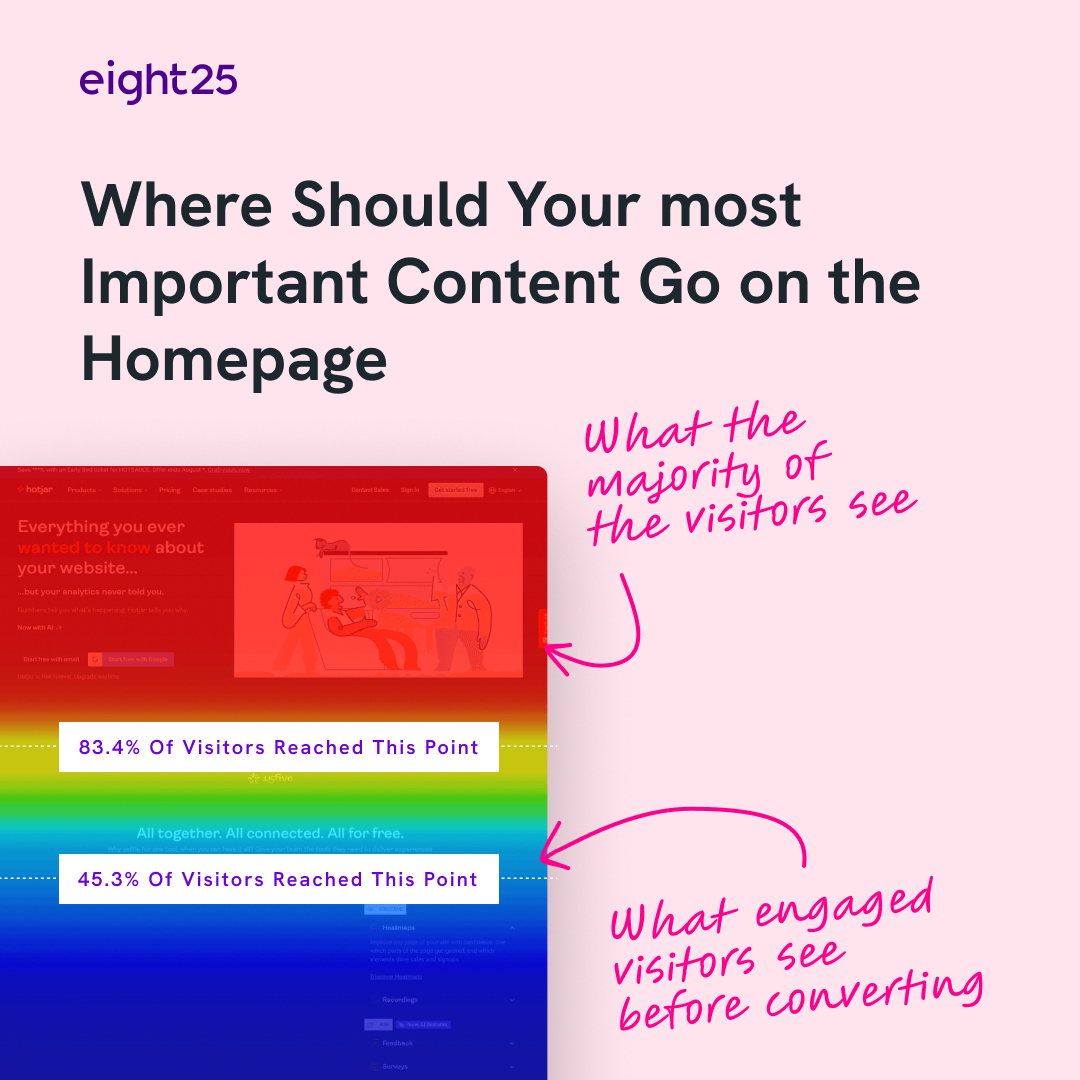Why Homepage Length Isn’t the Problem – Content Placement Is

If you’ve ever wondered how much of your homepage visitors actually read, the answer might surprise you.
After analyzing scroll maps across more than 340 websites, one insight became clear:
The most visited section of your website, but also the area with the highest bounce rate.
50% of all visitors don’t make it past the homepage hero and 70% of total bounces happen on the homepage hero.
Yet 60% of all visitors who go past the homepage hero make it all the way to the bottom.
So, why does this happen? A big reason is the way the hero section is structured. If it doesn’t immediately capture attention and clearly communicate your value, visitors are more likely to bounce.
So the real takeaway isn’t that your homepage is too long. It’s that strategic content placement matters far more than word count or page height.

The Misconception of “Shorter is Better”
Conventional wisdom says people have short attention spans. As a result, many businesses assume their homepage must be concise—often at the cost of critical information. But data tells a different story.
Length isn’t the enemy. In fact, longer pages with well-placed, relevant content consistently outperform shorter ones when it comes to engagement and conversion. What matters is what you place where.The key isn’t to reduce content indiscriminately. It’s to prioritize information based on how visitors interact with your page.
Using Scroll Maps to Guide Smart Design
Scroll maps offer a visual representation of how users engage with your content. You can identify exactly where visitors lose interest, pause, or accelerate their scrolling. These insights allow you to make informed decisions about what content deserves prominence—and what might be getting in the way.
Here’s how to get started:
- Locate the average fold
This is the point at which most screens cut off content on initial page load. A significant percentage of users won’t scroll beyond this unless they’re intrigued. - Identify engagement hotspots
These are areas where users spend more time or frequently stop scrolling. Often, these coincide with content that answers key questions or resolves uncertainty. - Pinpoint bounce zones
Sections where engagement drops sharply signal a mismatch—either the content lacks relevance, clarity, or persuasive power.
With this data, your homepage becomes less of a guessing game and more of a conversion engine.
Designing for Two Audiences: Skimmers and Scrollers
Your homepage needs to serve both:
- The Skimmer, who decides in seconds whether to stay. This person reads headlines, glances at subheadings, and quickly forms an impression.
- The Scroller, who is more engaged. They want details, proof, and reasons to believe—and they’re willing to scroll to get them.
To address both groups effectively:
- Position the most important content above the fold.
This includes your value proposition, core differentiator, and initial call to action. - Structure the rest of the page to build trust and deepen interest.
Include benefits, social proof, customer testimonials, and answers to common objections—strategically spread across the remaining sections.
Think of it as guiding a conversation. Your opening line needs to grab attention. But the rest of the dialogue must reinforce value and build momentum.
Homepage as a Narrative, Not a Checklist
Many homepages read like a compliance exercise—one section for every department, stacked without strategy. But a homepage isn’t a storage space; it’s a curated journey.
Instead of asking, “Did we include everything?”
Ask, “Are we telling a compelling story that leads the visitor toward a decision?”
Consider structuring your homepage into three logical parts:
- Top of page – Why should I care?
Hook the reader with clarity and relevance. - Middle of page – Tell me more.
Dive into benefits, differentiation, and proof points. - Bottom of page – I’m ready. What’s next?
Include testimonials, case studies, and a strong call to action.
When every section builds upon the one before it, you create flow—and flow leads to action.
Practical Next Steps
To make your homepage work harder:
- Install scroll mapping tools like Hotjar.
- Analyze drop-off points and high-engagement areas.
- Move your strongest content to areas with the highest visibility.
- Eliminate sections that distract or dilute your message.
- Continuously test and refine based on user behavior—not assumptions.
Final Thought: Layout is Leverage
A long homepage isn’t inherently a problem.
A poorly structured one is.
By leveraging behavioral data and aligning content with user intent, you can transform your homepage from a static information board into a dynamic narrative that converts.
Ultimately, the goal isn’t just to get visitors to scroll—it’s to keep them engaged as they do. When your content strategy supports that journey, every pixel of your homepage becomes a driver of value.